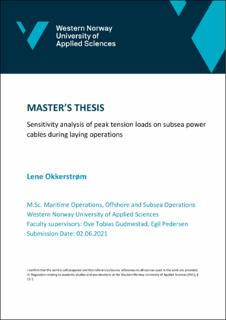| dc.description.abstract | Offshore wind is an evolving sector within the renewable energy industry. We can see trends where the wind farms are expanding in size and power capacity, as well as moving to locations further from shore and to larger depths. This presents its challenges to the growing cable network. Today we can see that a majority of the insurance claims in the offshore wind industry is due to cable faults, where a large percentage of these failures occur during the instalment of the inter-array and export cables.
Although the industry is relatively young, effort has been put in to identify the root causes of failure for these cables. A review was conducted on historical data and reliability data, with the goal to seek knowledge about these failures and their causes. The reliability statistics of cable failure is essential for cable installer, as well as the cable designer. As the reliability of the cables depends on the location and instalment method, it is important to map the risks and hazards that are involved which can compromise the cable’s integrity. A general hazard identification study (HAZID) was created in this thesis, based on voiced experiences within the industry through a workshop/brainstorming session and historical data found.
From the knowledge gained in the literature review, a sensitivity analysis was carried out to investigate crucial parameters in the cable laying process. The focus was on peak tension loads, and its relation to the key parameter of cable self-weight. This was conducted with both quasi-static forces and dynamic forces with irregular vessel motions. The findings of the sensitivity analysis illustrated the importance of proper cable design, related to each unique project.
The sensitivity of the cable’s deployment position from a vessel in irregular seas was also examined, with a dynamic analysis in the time domain. Which illustrated the impact of vessel motion response, in waves and current, on the maximum tension loads in the subsea cable. The finite element analyses were all performed by the aid of the software OrcaFlex, a well-tested software for analysis of marine operations. | en_US |

